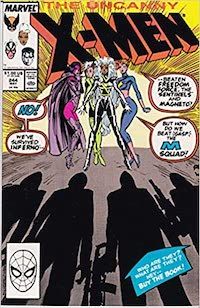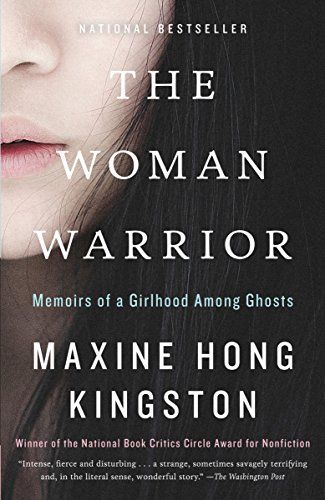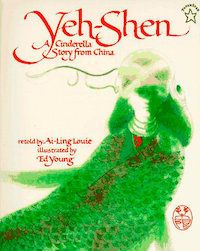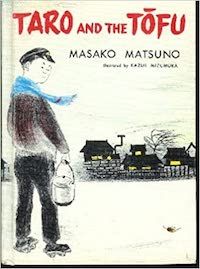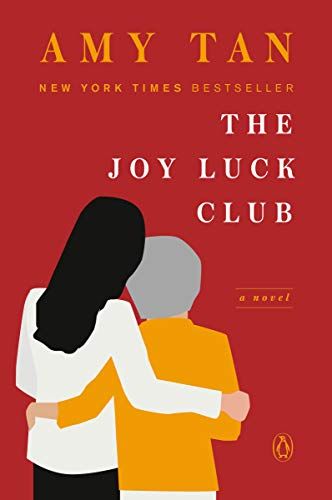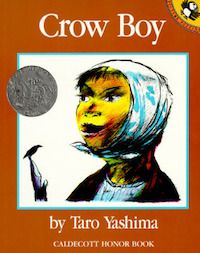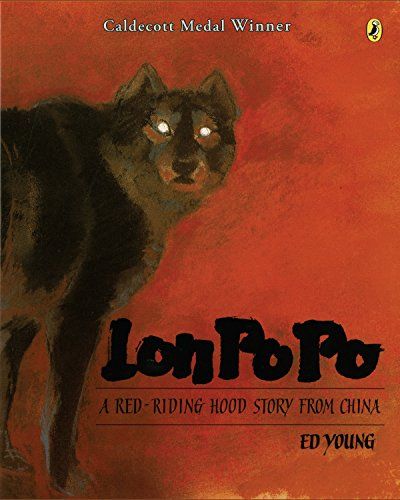Many of these readers remember the initial awe of seeing a character that looked like them for the very first time. Reader Angie Liang, who was “obsessed” as a child with fairytales and folktales from around the world, especially loved Ai-Ling Louie’s Yeh-Shen: A Cinderella Story from China. “[It] is the only book I can recall from childhood that had an Asian girl as the main focus,” she told me. Liang pored over the layout and illustrations, which struck her as “different and cool.” Author Kristan Hoffman was in kindergarten in the early 1990s when she received Lon Po Po: A Red-Riding Hood Story from China by Ed Young as a gift from a teacher. Hoffman knew her teacher picked that book specifically for her because of her heritage and while she had mixed feelings about receiving a different book from the other students, she was excited to see a story featuring Chinese culture. “[I]n retrospect, I appreciate that my teacher was thoughtful enough to build that cultural bridge for me,” she told me. “Especially as a mixed race person, I feel fortunate that from day one, there have been people who respected that part of me, helped me learn more about it, and celebrated it with me.” Some readers were excited in a way that they couldn’t yet articulate. When author S.K. Ali (Love from A to Z, Saints and Misfits) was around 8 years old, she read Masako Matsuno’s Taro and the Tofu and remembers “the delicious feeling of finding a book that just made sense.” She still credits that story as “[t]he very first book that I fell in love with, the one that turned me into a reader.” Author Misa Sugiura (This Time Will Be Different, It’s Not Like It’s a Secret) was already a dedicated reader when, in her junior year of college, she was introduced to her first novel by an Asian American author: The Joy Luck Club by Amy Tan. That experience surprised her with a new set of feelings: “I remember feeling so seen, so understood,” she told me. “The relationships that the daughters had with their mothers, their complicated feelings about their ethnicity and their cultural heritage, their experiences as Asians in a mostly white world—I’d never seen any of these experiences in a book, and they fed a hunger that I didn’t know I had.” The Joy Luck Club also elicited a strong emotion from author Lisa Yee (Millicent Min, Girl Genius, Absolutely Maybe, Aloha Kanani, and more), who doesn’t remember reading any books by Asian American or Pacific American authors when she was younger. She read The Joy Luck Club as an adult and, she told me, “I couldn’t stop crying when I got to the last page.” For these readers, a significant part of feeling seen and understood stemmed from recognizing aspects of their own lives in the pages of a story. Reader Jon Yee’s first encounters with Asian American characters happened while reading the comic books he loved. Yee discovered Jubilation Lee, a Chinese American character in the X-Men series from the early 1990s, when he was 10 years old. “Jubilee in particular resonated with me,” he told me, “because while she was dealing with being a mutant, she was also dealing with being a teenager. She wanted to fit in and assimilate into normal society, and those struggles and feelings were like my own.” Many readers recognized their families in stories about these characters. When thinking back on reading Taro and the Tofu for the first time, author Ali told me in an email, “I immediately connected with this tale about a test of conscience due to its emphasis on ethics (something drilled into us kids at home) and due to the family dynamics, which felt so similar to mine.” Reader and writer Monica Berry told me what resonated most for her when she read The Joy Luck Club was how the characters prioritized education, which was an important theme in her family as well. Not surprisingly, some of the emotionally charged experiences the readers described to me are painful. Authors Sugiura and Ellen Oh (The Dragon Egg Princess, Spirit Hunters, Prochecy, and more) both told me their earliest memories of Asian American characters were from stories that featured stereotypical characters, illustrated as caricatures. Oh, who is also co-founder of We Need Diverse Books, told me that when her teacher read that story out loud to the class, “I was vaguely troubled by it but couldn’t put my finger on why until recess when the other kids started saying ching chong and doing slanty eyes at me.” Even though she was only in the 1st or 2nd grade at the time, she describes it as “the first time I realized a book could be racist.” For reader Uyen Tran Parsons, the troubled feelings about how she was seen by others first came into focus for her later in life. In 2001, when she was 21 years old, she read Yellow: Race in America Beyond Black and White by Frank Wu. It was the first time she’d heard the terms “model minority myth” and “perpetual foreigner.” The explanations rang true for Tran Parsons. “My family had always been given so much credit for their hard work, ability to save money, and for raising a respectful and smart daughter,” she told me, “but with all this praise, I never felt as though we were fully accepted and embraced for who we are as Asians [or] Asian American[s].” Author Padma Venkatraman (The Bridge Home, A Time to Dance, Island’s End, Climbing the Stairs) was facing regular bullying by her classmates when her teacher read Crow Boy by Taro Yashima aloud to the class. Although Venkatraman grew up in India, she felt a powerful connection with Yashima’s protagonist. “[H]e had a secret gift and his friends were cruel to him, but in the end, they were forced to recognize it.” The discomfort for some readers, however, wasn’t imposed on them by others, but rather arose from within themselves. When author Randy Ribay (Patron Saints of Nothing, After the Shot Drops, An Infinite Number of Parallel Universes) read Maxine Hong Kingston’s The Woman Warrior: Memoirs of a Girlhood Among Ghosts in the 11th grade, he remembers “being kind of baffled by it at the time, having never read anything like it before and having not done any work toward processing my own Asian American identity yet.” When author Kelly Loy Gilbert (Conviction, Picture Us in the Light) read segments of The Joy Luck Club in her high school literature class, she felt pressure, as she told me, “to see myself in the story, for it to resonate, to finally recognize my own life within the pages of a book.” In some ways she did see herself, but in so many other ways even that story was still unfamiliar to her. “I’m from a different generation than Tan’s characters,” she told me, “and I didn’t have a framework yet for the idea of the single story, or the audacity to hunger for a multitude of Asian American stories that might capture a little more of what my own experience had been like.” For Marina Budhos (The Long Ride, Watched, The Professor of Light, and more), the discomfort was more obvious. One particular scene from The Woman Warrior: Memoirs of a Girlhood Among Ghosts is still seared into her memory, one in which the narrator tries to force another Chinese American girl to speak. “It was so awful, so truthful,” Budhos told me, “and it brought back all my own cruelties and mix-up about how distant I wanted to be from my background, how bossy I could be, how one lets out one’s fears on another Asian American kid.” One of the most profound emotions many of these readers took away from reading stories written by someone who looks like them is a sense of empowerment—even if it wasn’t fully formed yet. After Tran Parsons read Yellow: Race In America Beyond Black and White, she saw herself and the general Asian/Pacific American population in a new light. “I never learned about Japanese internment camps or social activists like Grace Lee Boggs and Helen Zia in school,” she told me. “[T]his book showed me that Asians play a significant role in furthering equality in this country for all people.” Many of the writers I reached out to told me about how these experiences inspired them to tell their own stories. Berry credits The Joy Luck Club as one of the stories, that have inspired her to write about her own identity. And Ali told me, “I don’t know if I’d be a writer today if my father hadn’t brought Taro and the Tofu home decades ago.” She keeps a copy of the book on the shelf above her writing desk to remind her “of the power of representation.” Budhos’s copy of The Woman Warrior: Memoirs of a Girlhood Among Ghosts, now worn and peppered with notes, influenced her second novel, The Professor of Light. “I knew I wanted to write a novel that melded myth and family history and had a kind of wildness of imagination,” Budhos told me. “I wanted to figure out how to capture the confusion of all these stories you hear from far off continents that clang inside you. I just didn’t know how to do it and this strange, wonderful book showed me the way.” Venkatraman told me this about the first Asian and Pacific American children’s authors she read: “I felt like [they] were saying, hey, we love our cultures and we love telling our own stories—and like they were telling me, somehow, Padma, you can write your own stories too and there are people willing to publish them.” While there will always be room and need for even more stories written by and featuring Asian and Pacific Americans, today’s readers have many more options available to them than most of these readers and authors did when they were seeking out their firsts. And that, many of them agree, is a reason to celebrate. As a tribute to the stories that positively influenced these readers and authors, here’s a list of the books they mentioned:
The Uncanny X-Men #244: Ladies’ Night (First Appearance of Jubilee) by Chris Claremont, illustrated by Mark Silvestri
Although the X-Men comic book series has been around since the 1960s, the character of Jubilation Lee, the daughter of Chinese immigrants, made her debut in 1989. After her parents are murdered, Jubilation (Jubilee) is discovered by the other women mutants when she’s living alone and surviving partly by her wits and partly thanks to her ability to generate pyrotechnic energy from her hands.
The Woman Warrior: Memoirs of a Girlhood Among Ghosts by Maxine Hong Kingston
Kingston blends memoir with mythology in this book, first published in 1976. Recalling her memories of growing up in California and listening to her mother’s stories about China, Kingston explores her family’s past, her own present, and how they affect her identity as a female Chinese American.
Yeh-Shen: A Cinderella Story from China by Ai-Ling Louie
This is a tale that’s been told in the author’s family for three generations. Through her research, Louie discovered it’s a story that has been shared in China since the T’ang dynasty (618–907 CE), more than 1,000 years before the first-known European version.
Taro and the Tofu by Masako Matsuno
On a cold, blustery night, after Taro buys tofu from the market, he realizes the seller has given him too much change. Taro faces an age-old dilemma for kids: should he keep the money or go back to return it?
The Joy Luck Club by Amy Tan
This is the story of four Chinese immigrant mothers, their daughters, and their families, all living in San Francisco. As family histories—and the secrets that come with them—are revealed, the women navigate the complexities of living as first-and-second generation Chinese Americans and how that identity affects their relationships with each other.
Yellow: Race in America Beyond Black and White by Frank Wu
Frank Wu, journalist, scholar, and activist, writes his perspective on race relations in the 21st century. A blend of anecdotes, case studies, and reporting, Wu explores a range of issues including affirmative action, globalization, and immigration through the lens of the Asian American experience.
Crow Boy by Taro Yashima
Chibi, who lives in a different village from his classmates, is considered an outcast. He hides under the schoolhouse, is too shy to make friends, and doesn’t learn the same way the other kids do. One day, a new teacher arrives and is determined to get to know Chibi in a way that no one else has ever bothered to before.
Lon Po Po: A Red-Riding Hood Story from China by Ed Young
When three children are left home alone, a wolf disguised as their grandmother (Po Po) comes to visit. Once they figure out this creature isn’t really their Po Po, the siblings devise a plan that will allow them to escape and also punish the wolf. To find more books written by Asian American authors, check out these lists compiled by Book Riot: 5 Great Books for Asian American and Pacific Islander Heritage Month 5 Nonfiction Audiobooks by Asian American Women Authors 6 of the Best Audiobooks by Korean American Women Writers
